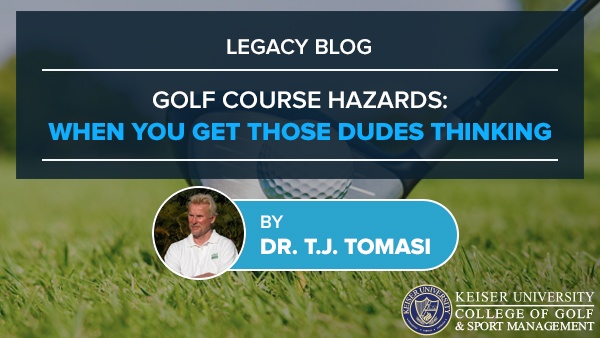Golf Course Hazards: When You Get Those Dudes Thinking

A Legacy Post by Keiser University College of Golf Senior Faculty and Director of Research Dr. T. J. Tomasi (1940-2023)
Some researchers believe that “trait” is the dominant influence on how long you will fixate on a threat – a trait is a control mechanism built into the human genome to keep you safe. Others believe it’s the “state” that’s the mitigating factor on how long you’ll focus on a threat – the particulars of the unique situation (the noise, the attackers, the trouble or in golf, the hazards specifically arrayed against you). Still others think it’s a combination of the two, but one thing is for sure – if you see the hazard as a threat, it will hold your attention until the threat is resolved.
Based on this evidence, golf course architects build in scary hazards to draw your attention away from hitting your target. They know that golf is best played by aiming at the target and worst played by trying to avoid the trouble – and there is much research to suggest that no matter the combination of state/trait, the more threatening a hazard appears to you, the more you will focus on the threat and ignore the real target – just what both the architect and your opponent want you to do.
Famed architect Pete Dye once said, ‘When you get those dudes thinking [about the hazards], they’re in trouble.’ And not only do golf course designers want you thinking about what danger lurks on the course, they want you to be visually intimidated, so they create a threatening array of bunkers, mounds, water, hump-back greens, and railway ties. Of course, they’re called “challenges,” but their real role is intimidation designed to trigger the threat/fixation reflex, a centuries old mechanism to keep us safe.
So remember: the label you put on the situation is the key factor – label it as dangerous, and you’ll produce scary pictures that you must fixate on. Then, instead of hitting “into the picture,” you’ll be trying to keep your ball “out of the picture.”
To avoid over-labeling a hazard’s “badness,” make sure to evaluate hazards simply as part of the architect’s defenses, a part of the scene, which is a small portion of the total picture. The key to being a good labeler is making the trouble appear small and the target to loom large. And remember that as far as real threats go, this isn’t lions, tigers, and bears; it’s only golf – so how real can the threat be?
Takeaway
Expert golfers not only swing well, they label well – and both are learned skills.
Learn more!
Want more tips? If you want to take your game to the next level, contact our team at Keiser University’s College of Golf & Sport Management today. With our dedication and experience, we can elevate your game to new heights together. Give us a call today at 888-355-4465.














